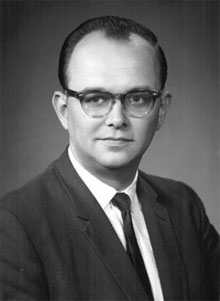
Everett
Hugh Everett III (November 11, 1930 – July 19, 1982) is the creator of the Many-Worlds Interpretation (MWI) of quantum mechanics, a.k.a. the Everett Interpretation. It was developed at length in his doctoral (‘long’) dissertation, ‘The Theory of the Universal Wave Function’, written under his supervisor J.A. Wheeler. It was cut down to a quarter of its size on Wheeler’s insistence and in this form it was awarded a doctorate and published as ‘‘‘Relative State’’ Formulation of Quantum Mechanics’ in Reviews of Modern Physics in 1957. According to the MWI, quantum theory can be applied to any physical system, no matter how large, and in principle to the entire universe. The quantum state always evolves in accordance with the deterministic, linear Schrodinger equation (the unitary dynamics). When an experiment is performed the unitary dynamics yields a superposition of states, whereas according to the conventional interpretation there results a unique measurement outcome associated with only one of these states (with probability given by the modulus square of the amplitude of that component). Reconciling these two features of the theory is called the measurement problem of quantum mechanics. According to MWI each term in the superposition gives rise to a measurement outcome, with the apparatus itself entering into a grand superposition with the system that is measured. The same applies to observers, if any, with the consequence that the superposition of distinct outcomes cannot itself be observed. The result is that the universal state is a superposition of states each of which describes a world observationally similar to our own. Such states (and sometimes sequences of such states) are called branches.
Although David Bohm, and before him Louis de Broglie, had already developed a realist formulation of quantum theory through the introduction of additional, ‘hidden’ variables, that likewise could be applied to closed systems (and ultimately the entire universe), its extension to relativistic quantum theory was far from obvious. The MWI in contrast required no additional variables and applied uniformly to quantum field theory and in particular to relativistic quantum theory. For this reason it was the first solution to the measurement problem that allowed quantum theory to be applied to relativistic cosmology. For early advocates of the theory like Bryce de Witt, a pioneer in the field of quantum gravity, this was its chief selling point. De Witt with his student Graham eventually published Everett’s ‘long’ dissertation in their compilation of papers in The Many Worlds Interpretation of Quantum Mechanics, Princeton University Press (1973).
Everett also provided one of the first derivations of the Born rule, based on the assumption that a probability measure over branches is a function of branch- amplitudes. He did not, however, address the more general question of why the quantum state should be represented as one particular superposition of branches rather than another, nor why the measure should be a function of branch-amplitudes, questions eventually addressed by decoherence theory and later derivations of the Born rule, including the decision-theoretic approach of David Deutsch and David Wallace.
So discouraged was Everett at the poor reception of his ideas that he never sought a professional position. He was a pioneer of the technique of generalized Lagrange multipliers in operational research and a director of the Weapons Systems Evaluation Group at the Pentagon.
Links
‘”Relative State” Formulation of Quantum Mechanics’, by H. Everett III >
‘The Theory of the Universal Wave Function’, by H. Everett III >
‘The Many Worlds of Hugh Everett’, by Peter Byrne >
Stanford Encyclopedia of Philosophy: Everett’s Relative-State Formulation of Quantum Mechanics>
Stanford Encyclopedia of Philosophy: The Many-Worlds Interpretation of Quantum Mechanics>
